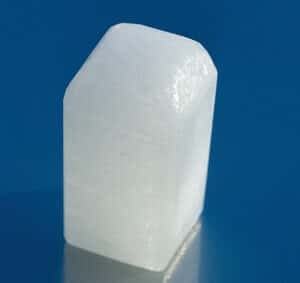
Americans hate body odor. That is why we embrace antiperspirants and deodorants with such enthusiasm. Many people are leery of the aluminum found in antiperspirants, though. That’s why they have gravitated towards natural crystal deodorants. Americans love the word “natural.” They automatically assume it must be safe. And yet many natural products are not necessarily harmless. This reader wants to know about natural alum crystal deodorants.
How Safe Is Alum in Underarms?
Q. Would you please comment on the safety of alum as a deodorant? I think it is the ingredient in many “Crystal” antiperspirant products.
A. We have heard from lots of readers that they gave up aluminum-based antiperspirants because of a fear of either Alzheimer’s disease or cancer. Here are just a couple of examples:
“The women in our family have been using crystal roll-on for some time, as we’ve been avoiding aluminum and parabens for years and we find that it works well.”
and
“For more than 10 years I’ve used deodorant-only products, because someone warned of a cancer risk. It’s a bit hard to find, but I found a crystal roll-on product that is fragrance, paraben and aluminum chlorohydrate free. Seems to work well. If I hadn’t just bought a new bottle, I’d try the Graedons’ Milk of Magnesia roll-on deodorant.”
and
“Have started using crystal roll on deodorant which is paraben free and is a natural product. It is made from mineral salts and is also hypoallergenic and safe for the environment.”
What’s in Natural Crystal Deodorants?
Crystal deodorant sounds like the ideal solution for avoiding aluminum in an antiperspirant. There is one significant problem, however. Many of the manufacturers of such products are very cagey about the ingredients in their “natural” crystal deodorant products. There is no doubt that such products are natural, since aluminum is a mineral found in nature. You will sometimes see the word “alum” or potassium alum as the main ingredient.
The online Merriam-Webster dictionary defines alum as:
“a potassium aluminum sulfate KAl(SO4)2·12H2O or an ammonium aluminum sulfate NH4Al(SO4)2·12H2O used especially as an emetic [causes vomiting] and as an astringent and styptic [to prevent bleeding].”
Alum has been used for a very long time in reservoirs to clarify water. That is, it helps suspended particles settle to the bottom so they can be removed. It has also been used as a remedy for canker sores and in a styptic pencil to stop bleeding after shaving. That said, there is no doubt that alum contains aluminum, often hydrated potassium aluminum sulfate (potassium alum). Anyone who thinks that using a natural crystal deodorant eliminates aluminum is kidding herself.
How Concerned Should We Be About Aluminum?
Is the aluminum in natural crystal deodorants dangerous? That is a question that remains unanswered. How much aluminum is absorbed from delicate underarm tissue? No one has a good answer. That in itself is astonishing, since tens of millions of people use products with aluminum every day. They do this for decades. If aluminum is absorbed, does it pose any health risk?
Aluminum in Cooking Utensils?
Most health professionals have ridiculed the idea that people could absorb aluminum from pots, pans and other cooking utensils. A study published in The Journal of the Association of Physicians of India (April, 2019) has us wondering whether this is something to be concerned about after all.
People with end stage kidney disease have to rely upon dialysis to survive. In many respects they are like canaries in the coal mines. That’s because they are especially vulnerable to toxic chemicals.
There was a time when many suffered from chronic aluminum toxicity (CAT). That’s because the water that was used in the dialysis process often contained varying quantities of aluminum. In addition, people undergoing dialysis were once given aluminum hydroxide (the same ingredient found in many antacids) to bind phosphate.
The result of the buildup of excess aluminum in these patients was a severe and sometimes fatal brain disorder (Archives of Pathology & Laboratory Medicine, June 14, 2018). There was even a name for it: “dialysis encephalopathy.” It was characterized by neurological symptoms such as speech disorders, confusion, convulsions and dementia (Nephrology, Dialysis Transplantation, Aug. 16, 2005). This condition has virtually disappeared because the water used in dialysis is now purified and no longer contains aluminum. In addition, patients are no longer given aluminum hydroxide.
The study from India notes that chronic aluminum toxicity (CAT) in kidney dialysis patients could be associated with aluminum pots and pans:
“Use of aluminum utensils for cooking meals is associated with CAT.”
We recognize that this association was identified in kidney dialysis patients who are extremely sensitive to aluminum. But if our canary-in-the-coal-mine analogy holds up, the rest of us may not be completely immune to potential aluminum toxicity.
Aluminum and the Breast:
An article in the Journal of the National Cancer Institute (Oct 16, 2002) concluded that there was no connection between use of antiperspirants and the risk of breast cancer.
More recently, though, a study suggests that aluminum compounds can change the way breast cells divide, even at low concentrations (Journal of Applied Toxicology, online, Jan. 6, 2012).
The authors of this research conclude:
“Our observations do not formally identify aluminium [British spelling for aluminum] as a breast carcinogen, but challenge the safety ascribed to its widespread use in underarm cosmetics.”
There is also research to suggest that aluminum concentrates in breast tissue, possibly from exposure to aluminum-containing antiperspirants (Journal of Applied Toxicology, April, 2011).
A study in the Journal of Inorganic Biochemistry (Nov. 2011) points out that:
“The human breast is exposed to aluminium from many sources including diet and personal care products, but dermal [skin] application of aluminium-based antiperspirant salts provides a local long-term source of exposure.”
These researchers note that nipple aspirate fluids have been shown to contain aluminum at higher levels in breast cancer patients than from healthy control subjects “providing evidence of raised aluminium levels in the breast microenvironment when cancer is present.”
A thoughtful review of this entire topic was published in Best Practice & Research. Clinical Endocrinology and Metabolism by a British oncology professor.
Some of the comments include:
“Several components of cosmetics have genotoxic properties, including the aluminium salts..”
“Dermal absorption of topically applied antiperspirant aluminium salts has been demonstrated through intact mouse skin and and the skin of the human underarm. Aluminium in the form of aluminium chloride or aluminium chlorhydrate has been shown capable of interfering with the function of oestrogen receptors of human breast cancer cells both in terms of ligand binding and oestrogen-regulated gene expression.”
That is, these compounds may act as hormone disruptors.
Aluminum and the Brain:
It comes as a surprise to most health professionals to learn that basic researchers have categorized aluminum as a neurotoxin. An article in Food and Chemical Toxicology (Sept. 2017) notes:
“Neurotoxicity of Al [aluminum] is well established and linked to oxidative damage and neurodegeneration.”
Aluminum appears to cause oxidative stress in the brain. It does this in part by increasing inflammatory cytokines. These proteins are crucial cellular messengers that can lead to inflammation. Some neuroscientists now believe that Alzheimer’s disease is largely an inflammatory disease and that aluminum may play a role in its etiology.
An article in the journal Metabolic Brain Disease (July 27, 2017) notes:
“Intriguingly, chronic or cumulative exposure to aluminium reflected by increased levels in cerebrospinal fluid (CSF) and serum may be one environmental factor in the pathogenesis and pathophysiology of MS [multiple sclerosis], Parkinson’s disease (PD) and AD [Alzheimer’s disease]. There is a wealth of research examining the potential association between increased exposure to environmental aluminium and the development of the last of these illnesses. Indeed, a recent meta-analysis involving eight cohort- and case-controlled studies conducted prior to 2015 involving 10,567 participants concluded that increased aluminium exposure increased the risk of developing AD by some 71%.”
The authors conclude:
“Aluminium has no known beneficial physiological action in the human body and some genetic polymorphisms predispose to a greater susceptibility to its adverse effects. Therefore, a strong case can be made for avoiding unnecessary exposure to environmental sources of aluminium salts, especially on the part of children, pregnant mothers and women of child- bearing age who may become pregnant. Such avoidance need not lead to hardship or inconvenience; aluminium cookware may be replaced by safer alternatives, while aluminium- containing antiperspirants, potentially implicated in the rise of cases of breast cancer particularly affecting the upper outer quadrant of the mammary gland, may be replaced by non- aluminium versions.”
Are There Alternatives to Aluminum?
It will probably take many more years to resolve the controversy about any relationship between aluminum and breast cancer or Alzheimer’s disease. In the meantime, people who seek to avoid aluminum in their armpits will probably want to look beyond crystal deodorants. Many people find that milk of magnesia (MoM) applied to the underarm helps against odor, so that may be an attractive alternative. There is more information about this here. You can also learn about our aluminum-free, magnesium-based People’s Pharmacy Roll-on Deodorants here.


